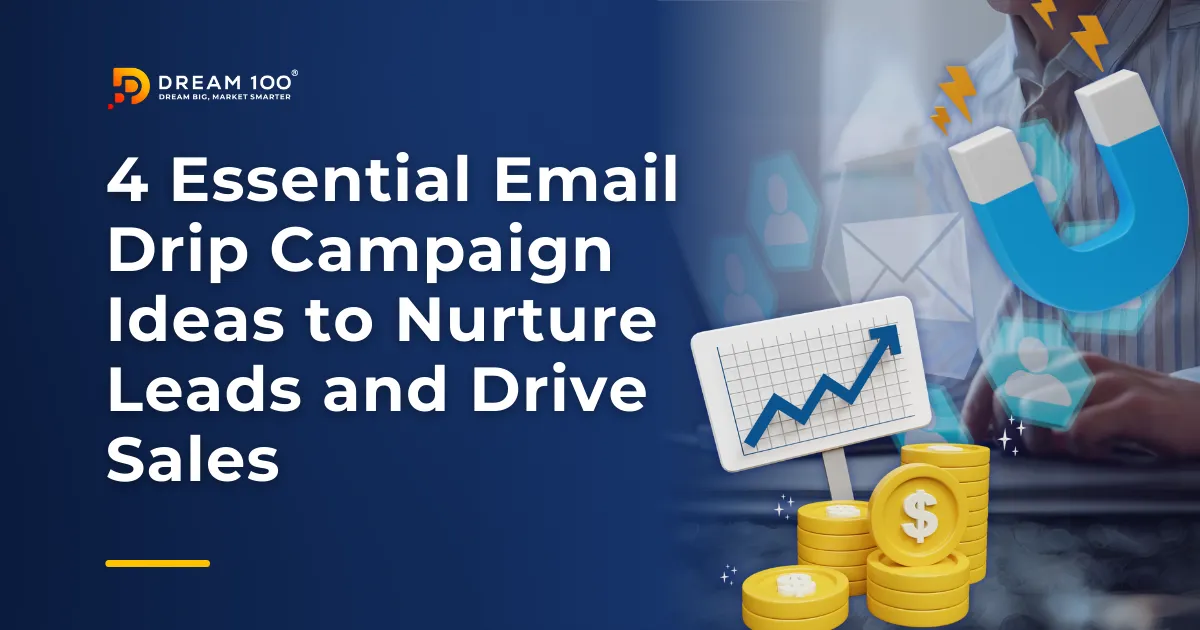Email drip campaign ideas are crucial for enhancing your marketing strategy to nurture leads and drive sales. An email drip campaign has a series of messages automatically sent based on specific timelines or user actions. This method ensures sustained engagement with potential customers, smoothly guiding them through the buying journey.
This blog post will discuss four essential email drip campaign approaches designed to nurture leads and convert them into loyal customers effectively. Each idea caters to different stages of the customer lifecycle, ensuring a personalized experience that truly resonates with your audience.
1. B2B Email Campaign Drip: Leveraging Automation for Effective Lead Conversion

B2B email campaign drips are automated email sequences strategically designed to engage business clients over time, typically aligning with the sales cycle’s length and complexity. These campaigns are crucial for maintaining communication without manual effort and nurturing prospects through personalized and relevant content. The goal is to gradually develop trust and guide potential customers from awareness to decision-making stages, culminating in a conversion or sale.
Critical Elements of Successful B2B Drips
To ensure the effectiveness of a B2B email drip campaign, consider incorporating these critical elements:
- Segmentation: Tailor your emails to address the specific needs and characteristics of different segments within your audience. This could be based on industry, company size, or position in the sales funnel.
- Content Relevance: Each email should provide value relevant to the recipient’s current stage in the buyer’s journey. In the early stages, focus on educational content; later, emphasize product benefits and customer testimonials.
- Strong Call-to-Action (CTA): Every email should have a clear and compelling CTA, whether it’s to download a white paper, schedule a demo, or visit a landing page. The CTA should align with the goal of moving the prospect to the next stage of the sales funnel.
- Timing and Frequency: The timing and frequency of emails should be optimized to maintain engagement without overwhelming recipients. This requires understanding your B2B clients’ typical decision-making timeline.
Example of a High-Performing B2B Drip Campaign
A successful example of a B2B drip campaign was implemented by a SaaS provider targeting mid-size tech companies. The campaign included:
- An initial welcome email with a brief introduction to the platform and a link to an informational blog post.
- Follow-up emails spaced two days apart, featuring case studies of similar companies and the benefits they realized.
- A mid-campaign check-in via an email poll asking if recipients had specific questions or needed further information.
- A final call-to-action email inviting recipients to a free webinar showcasing the software’s latest features and a live Q&A session.
This campaign resulted in a 25% increase in demo requests and significantly improved lead conversion rates by keeping potential customers engaged and informed throughout their decision-making process.
2. Drip Email Campaign Workflow: Mapping Your Path to Success

Before launching a drip email campaign workflow, it’s essential to clearly set what you aim to achieve and who you intend to reach. Goals might range from increasing product awareness to nurturing leads to re-engaging dormant customers.
Equally important is understanding your audience. This involves separating your email list based on criteria such as demographic data, past interactions, and behavioral patterns to ensure that the content is highly relevant and engaging.
Steps to Design an Efficient Workflow
Creating an effective drip email campaign workflow involves several key steps:
- Segment Your Audience: Segment your email list into distinct segments based on each recipient’s unique attributes and needs. This ensures that each recipient receives relevant and timely content.
- Map Out the Email Sequence: Determine the number and types of emails that will be part of the sequence. This usually starts with a welcoming email, followed by content that builds upon the previous emails, and ends with a solid call to action.
- Content Planning: Develop compelling and valuable content for each customer journey stage. Early-stage content might be educational, while later content should help overcome objections and nudge toward a purchase.
- Scheduling: Decide the timing and frequency of each email. The schedule should consider your audience’s behavior and preferences to maximize open and engagement rates.
Tools and Technologies to Streamline Your Processes
Several tools and technologies can help streamline your drip email campaign workflow:
- Email Automation Platforms: Tools like Mailchimp, HubSpot, or ActiveCampaign offer automation capabilities to trigger emails based on your recipients’ actions.
- CRM Integration: Integrating your email system with a CRM allows you to dynamically update customer information and personalize emails based on real-time data.
- Analytics and Reporting Tools: Utilize analytics to monitor the performance of your drip campaigns. To refine and optimize your emails, look for insights into open rates, click-through rates, and conversions.
Using these tools effectively allows you to create a more personalized, engaging, and successful email drip campaign that aligns with your strategic goals and meets the needs of your audience.
3. Email Drip Campaign Frequency: Timing Your Messages for Maximum Impact

The email drip campaign frequency is critical and can dramatically affect the success of your marketing efforts. If emails are sent too frequently, there is a risk of annoying your audience, which might lead to higher unsubscribe rates.
On the other hand, if emails are sent too infrequently, you might fail to keep your brand top-of-mind, potentially missing out on engagement opportunities. Finding the optimal balance is crucial for maintaining interest and optimizing the response from your audience.
Guidelines for Timing Your Emails
To determine the ideal timing for your email drip campaigns, consider the following guidelines:
- Understand Your Buyer’s Journey: The frequency of emails should correlate with the stages of your buyer’s journey. For instance, more frequent communication may be beneficial during the initial stages of a relationship when you’re building awareness.
- Purpose of the Email: Determine the purpose of each email in your drip campaign. Transactional emails require immediate sending, whereas educational content might be spaced over several days or weeks.
- Industry Standards: Research and adhere to common practices within your industry. Some sectors, like retail, may benefit from more frequent emails, especially during high shopping seasons, while B2B sectors might see better results with less frequent, more content-rich emails.
Adjusting Frequency Based on Engagement Metrics
Regularly analyzing engagement metrics is vital to optimizing the frequency of your drip campaigns. Key metrics to monitor include:
- Open Rates: Track how often your emails are opened in relation to the frequency with which they are sent. A drop in open rates might suggest that you need to reduce frequency.
- Click-Through Rates (CTR): Monitor the rate at which people click the links within your emails. Low CTRs indicate email fatigue or irrelevant content.
- Unsubscribe Rates: An increase in unsubscribes can indicate that your emails are too frequent.
Adjusting your email frequency based on these metrics allows you to adjust your campaign to meet your audience’s preferences more effectively. Experiment with different frequencies and carefully observe the impact on engagement. Use A/B testing to compare different intervals and fine-tune your strategy, ensuring each email adds value and keeps your audience engaged.
4. Measuring Success: Tracking the Performance of Your Email Drip Campaigns

To effectively estimate the success of your email drip campaigns, it is crucial to focus on several key metrics that reflect the engagement and conversion rates generated by your emails:
- Open Rate: This calculates the percentage of recipients who opened your email. It helps gauge its initial appeal, including the effectiveness of your subject line.
- Click-Through Rate (CTR): This indicates the percentage of email recipients who clicked on one or more links within the email. CTR helps assess the relevance and attractiveness of the content and call to action.
- Conversion Rate: This tracks how many email recipients took the desired action, such as filling out a form or purchasing. It directly correlates with the ultimate effectiveness of the email campaign in driving sales or desired outcomes.
- Bounce Rate: Monitoring the number of emails that were not successfully delivered can help you maintain a clean, up-to-date email list.
- Unsubscribe Rate: This metric is crucial for understanding how many users opt out of your email list after receiving your emails, providing insights into the overall reception of your campaign.
Tools for Monitoring Campaign Effectiveness
Several tools and platforms can enhance your ability to monitor these metrics effectively:
- Email Marketing Platforms: Services like Mailchimp, Constant Contact, and HubSpot offer built-in analytics features that track open rates, CTRs, conversions, and more.
- Google Analytics: By integrating Google Analytics with your email campaigns, you can track how email traffic behaves on your website, providing deeper insights into user engagement and conversion.
Using Insights to Optimize Future Campaigns
Leveraging the data collected from these tools allows for the continuous improvement of your campaigns:
- Test and Refine: Use A/B testing to experiment with different email elements, such as subject lines, content, and send times, to see what resonates best with your audience.
- Segmentation: Enhance personalization by segmenting your audience based on behavior and engagement metrics. Tailor content to better meet the requirements and interests of different groups.
- Feedback Loops: Implement mechanisms for gathering direct feedback from your audience about their preferences and experiences. This can provide qualitative insights that complement your quantitative data.
By regularly analyzing these metrics and adjusting your strategies accordingly, you can continually enhance the effectiveness of your email drip campaigns, ensuring they remain a valuable tool for growing leads and driving conversions.
Conclusion
As we’ve explored in our discussion of the four essential email drip campaign ideas, the power of effectively designed and timed emails can significantly elevate your lead nurturing efforts and drive sales. With tools and strategies tailored for everything from defining your campaign goals to analyzing its success, Dream 100® is here to help you master the art of email marketing. Each approach offers a unique opportunity to deepen connections with your audience, ensuring that every campaign is heard, resonates, and inspires action.
Let Dream 100® help you craft a winning strategy that reaches and exceeds your marketing goals. Ready to elevate your email marketing game? Visit us at Dream 100® Contact Us to get started today. Let’s make every email count!




